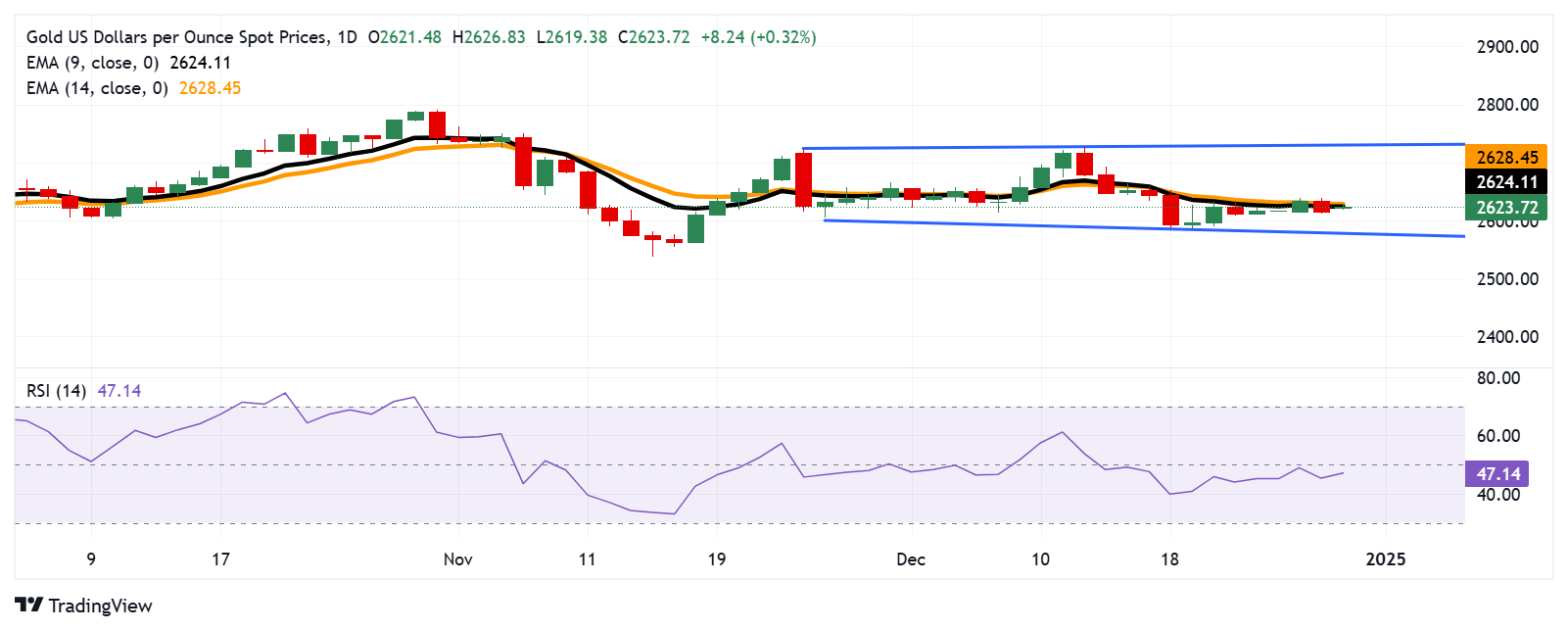Gold price receives support from safe-haven demand ahead of Trump administration
- Gold price advances due to increased risk aversion ahead of the incoming Trump administration.
- The precious metal may struggle due to the outlook for fewer Fed rate cuts in 2025.
- Israeli forces carried out attacks on two hospitals in northern Gaza on Sunday.
Gold price (XAU/USD) recovers its recent losses from the previous session, although trading volume is lighter on Monday than usual ahead of the New Year holiday. The safe-haven Gold gains upward support as markets anticipate signals regarding the United States (US) economy under the incoming Trump administration and the Federal Reserve’s (Fed) interest rate outlook for 2025.
The safe-haven demand for the yellow metal could increase as the potential Donald Trump’s tariffs and trade policies could trigger trade conflicts, increasing the risk aversion sentiment. However, the outlook for fewer Fed rate cuts in 2025 might cap the upside for the price of the non-yielding Gold.
Additionally, Gold receives upward support from heightened geopolitical risks stemming from the prolonged Russia-Ukraine conflict and ongoing tensions in the Middle East. On Sunday, Israeli forces carried out attacks on two hospitals in northern Gaza, including a strike on the upper floor of al-Wafaa Hospital in Gaza City, which killed at least seven people and critically wounded others.
Gold prices are set to finish the year with an impressive 27% gain, representing their strongest annual performance since 2010. This rally has been driven by central bank purchases, rising geopolitical tensions, and monetary easing policies implemented by major central banks.
Gold price edges higher as US Dollar remains subdued as Treasury yields depreciate
- The US Dollar Index (DXY), which measures the value of the US Dollar (USD) against its six major peers, trades around 108.00, slightly below its highest level since November 2022. Traders continue to digest the US Federal Reserve’s (Fed) hawkish pivot. The Fed cut its benchmark interest rate by a quarter point at the December meeting, and the latest Dot Plots indicated two rate cuts next year.
- The non-interest-bearing Gold may receive support as US Treasury bond yields depreciate on Monday. 2-year and 10-year yields stand at 4.32% and 4.62%, respectively, at the time of writing.
- On Thursday, Russia's Federal Security Service announced that it had thwarted multiple assassination plots by Ukrainian intelligence targeting high-ranking Russian officers and their families in Moscow. The agency stated that the attacks were planned using bombs disguised as power banks or document folders, according to Reuters.
- The Federal Reserve signaled a more cautious outlook for additional rate cuts in 2025, marking a shift in its monetary policy stance. This development highlights uncertainties surrounding future policy adjustments amid the anticipated economic strategies of the incoming Trump administration.
Technical Analysis: Gold price tests nine-day EMA above $2,600
Gold price trades near $2,620.00 on Monday, with the daily chart indicating a consolidation phase as the metal moves sideways near the nine- and 14-day Exponential Moving Averages (EMAs). The 14-day Relative Strength Index (RSI) hovers just below the 50 mark, reflecting a neutral sentiment. A decisive move above 50 could signal increased buying interest in the commodity.
Regarding its resistances, the XAU/USD pair may target the psychological level of $2,700.00, with the next barrier at its monthly high of $2,726.34, which was recorded on December 12.
On the downside, the XAU/USD pair may find its immediate support around the nine- and 14-day EMAs at $2,624.00 and $2,628.00, respectively. A break below these levels could increase selling pressure, potentially pushing Gold toward its monthly low of $2,583.39.
XAU/USD: Daily Chart

Gold FAQs
Gold has played a key role in human’s history as it has been widely used as a store of value and medium of exchange. Currently, apart from its shine and usage for jewelry, the precious metal is widely seen as a safe-haven asset, meaning that it is considered a good investment during turbulent times. Gold is also widely seen as a hedge against inflation and against depreciating currencies as it doesn’t rely on any specific issuer or government.
Central banks are the biggest Gold holders. In their aim to support their currencies in turbulent times, central banks tend to diversify their reserves and buy Gold to improve the perceived strength of the economy and the currency. High Gold reserves can be a source of trust for a country’s solvency. Central banks added 1,136 tonnes of Gold worth around $70 billion to their reserves in 2022, according to data from the World Gold Council. This is the highest yearly purchase since records began. Central banks from emerging economies such as China, India and Turkey are quickly increasing their Gold reserves.
Gold has an inverse correlation with the US Dollar and US Treasuries, which are both major reserve and safe-haven assets. When the Dollar depreciates, Gold tends to rise, enabling investors and central banks to diversify their assets in turbulent times. Gold is also inversely correlated with risk assets. A rally in the stock market tends to weaken Gold price, while sell-offs in riskier markets tend to favor the precious metal.
The price can move due to a wide range of factors. Geopolitical instability or fears of a deep recession can quickly make Gold price escalate due to its safe-haven status. As a yield-less asset, Gold tends to rise with lower interest rates, while higher cost of money usually weighs down on the yellow metal. Still, most moves depend on how the US Dollar (USD) behaves as the asset is priced in dollars (XAU/USD). A strong Dollar tends to keep the price of Gold controlled, whereas a weaker Dollar is likely to push Gold prices up.

